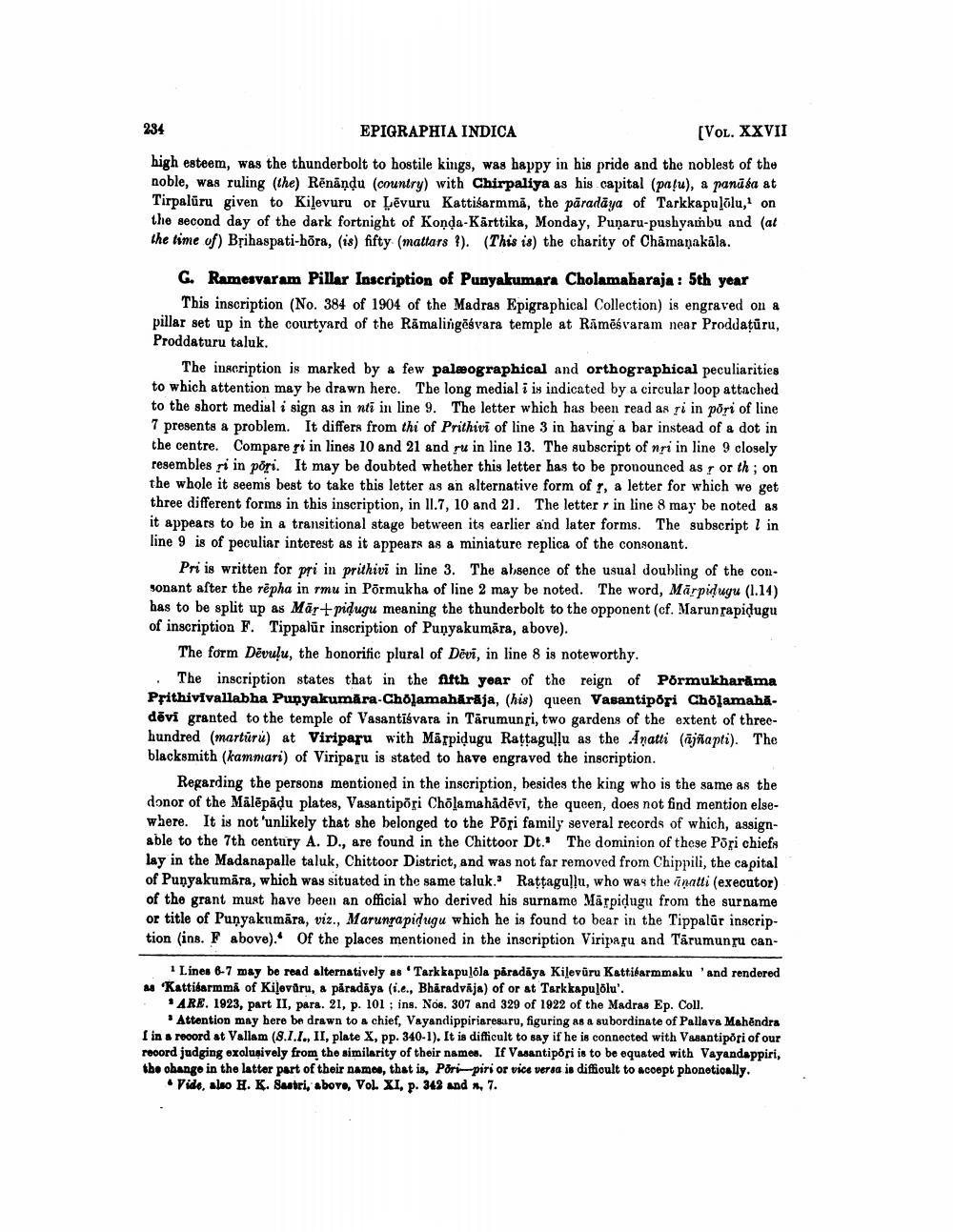________________
234
EPIGRAPHIA INDICA
[VOL. XXVII high esteem, was the thunderbolt to hostile kings, was happy in his pride and the noblest of the noble, was ruling (the) Renāṇḍu (country) with Chirpaliya as his capital (patu), a panāśa at Tirpaluru given to Kilevuru or Lēvuru Kattisarmma, the paradaya of Tarkkapulōlu,1 on the second day of the dark fortnight of Konda-Kärttika, Monday, Punaru-pushyambu and (at the time of) Brihaspati-hōra, (is) fifty (mattars ?). (This is) the charity of Chamaņakāla.
G. Ramesvaram Pillar Inscription of Punyakumara Cholamaharaja: 5th year
This inscription (No. 384 of 1904 of the Madras Epigraphical Collection) is engraved on a pillar set up in the courtyard of the Ramalingesvara temple at Ramēs varam near Proddaṭūru, Proddaturu taluk.
The inscription is marked by a few paleographical and orthographical peculiarities to which attention may be drawn here. The long medial i is indicated by a circular loop attached to the short medial i sign as in nti in line 9. The letter which has been read as ri in pori of line 7 presents a problem. It differs from thi of Prithivi of line 3 in having a bar instead of a dot in the centre. Compare ri in lines 10 and 21 and ru in line 13. The subscript of nri in line 9 closely resembles ri in pori. It may be doubted whether this letter has to be pronounced as r or th; on the whole it seems best to take this letter as an alternative form of r, a letter for which we get three different forms in this inscription, in 11.7, 10 and 21. The letter r in line 8 may be noted as it appears to be in a transitional stage between its earlier and later forms. The subscript in line 9 is of peculiar interest as it appears as a miniature replica of the consonant.
Pri is written for pri in prithivi in line 3. The absence of the usual doubling of the consonant after the repha in rmu in Põrmukha of line 2 may be noted. The word, Märpidugu (1.14) has to be split up as Mar+pidugu meaning the thunderbolt to the opponent (cf. Marun rapiḍugu of inscription F. Tippalur inscription of Punyakumara, above).
The form Devulu, the honorific plural of Devi, in line 8 is noteworthy.
The inscription states that in the fifth year of the reign of Pōrmukharāma Prithivivallabha Puṇyakumara-Chōļamahārāja, (his) queen Vasantipōri Chōlamahādevi granted to the temple of Vasantiśvara in Tarumungi, two gardens of the extent of threehundred (martüru) at Viriparu with Marpiḍugu Raṭṭagullu as the Anatti (ajñapti). The blacksmith (kammari) of Viriparu is stated to have engraved the inscription.
Regarding the persons mentioned in the inscription, besides the king who is the same as the donor of the Mālēpāḍu plates, Vasantipori Chōlamahādēvi, the queen, does not find mention elsewhere. It is not 'unlikely that she belonged to the Pōri family several records of which, assignable to the 7th century A. D., are found in the Chittoor Dt. The dominion of these Pōri chiefs lay in the Madanapalle taluk, Chittoor District, and was not far removed from Chippili, the capital of Punyakumara, which was situated in the same taluk. Raṭṭagullu, who was the inatti (executor) of the grant must have been an official who derived his surname Marpiḍugu from the surname or title of Puṇyakumara, viz., Marunṛapidugu which he is found to bear in the Tippalur inscription (ins. F above). Of the places mentioned in the inscription Viriparu and Tarumunru can
1 Lines 6-7 may be read alternatively as 'Tarkkapulōla paradāya Kilevuru Kattiéarmmaku 'and rendered as Kattisarmma of Kijevůru, a paradaya (i.e., Bharadvaja) of or at Tarkkapulōlu'.
*ARE. 1923, part II, para. 21, p. 101; ins. Nos. 307 and 329 of 1922 of the Madras Ep. Coll.
* Attention may here be drawn to a chief, Vayandippiriaresaru, figuring as a subordinate of Pallava Mahendra I in a record at Vallam (8.1.I., II, plate X, pp. 340-1). It is difficult to say if he is connected with Vasantipori of our record judging exclusively from the similarity of their names. If Vasantipori is to be equated with Vayandappiri, the change in the latter part of their names, that is, Pori-piri or vice versa is difficult to accept phonetically.
Vide, also H. K. Sastri, above, Vol. XI, p. 342 and n. 7.




